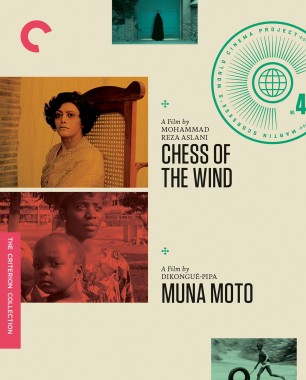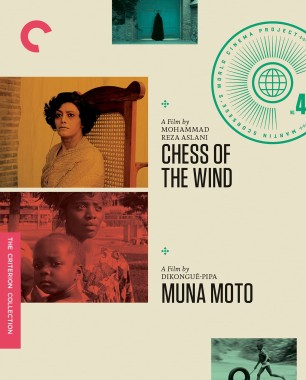Martin Scorsese’s World Cinema Project No. 4

Established by Martin Scorsese in 2007, The Film Foundation’s World Cinema Project has maintained a fierce commitment to preserving and presenting masterpieces from around the globe, with a growing roster of dozens of restorations that have introduced moviegoers to often overlooked areas of cinema history. This collector’s set gathers six important works, from Angola (Sambizanga), Argentina (Prisioneros de la tierra), Iran (Chess of the Wind), Cameroon (Muna moto), Hungary (Two Girls on the Street), and India (Kalpana). Each title is an essential contribution to the art form and a window onto a filmmaking tradition that international audiences previously had limited opportunities to experience.
Films In This Set
-

Sambizanga
1972
This revolutionary bombshell by Sarah Maldoror chronicles the awakening of Angola’s independence movement. Based on a true story, Sambizanga follows a young woman as she makes her way from the outskirts of Luanda toward the city’s center looking for her husband after his arrest by the Portuguese authorities—an incident that will ultimately help to ignite a national uprising. Featuring a cast of nonprofessionals—many of whom were themselves involved in anticolonial resistance—this landmark work of political cinema honors the essential roles of women, as well as the hardships they endure, in the global struggle for liberation.
-

Prisioneros de la tierra
1939
Shot on location in the jungle, this gut-punching work of social realism by Mario Soffici—one of classic Argentine cinema’s foremost directors—simmers with rage against worker oppression. Desperate men are entrapped into indentured labor on a yerba maté plantation under the brutal foreman Köhner—a situation made tenser by the fact that both Köhner and a worker named Podeley love Andrea, the sweet-spirited daughter of the camp’s doctor, and that eventually boils over into an explosive rebellion led by Podeley. The expressionistic cinematography of Pablo Tabernero feverishly evokes a place where suffocating heat, economic exploitation, and cruelty lead inexorably to madness and violence.
-

Chess of the Wind
1976
This rediscovered jewel of Iranian cinema has reemerged as one of the most astonishing works of the country’s prerevolutionary New Wave. A hypnotically stylized murder mystery awash in period atmosphere, Chess of the Wind unfolds inside a candlelit mansion, where a web of greed, violence, and betrayal ensnares potential heirs as they vie for control of their matriarch’s estate. Melding the influences of European modernism, gothic horror, and classical Persian art, Mohammad Reza Aslani crafts an exquisitely restrained mood piece that erupts into a subversive final act in which class conventions, gender roles, and time itself are upended with shocking ferocity.
-

Muna moto
1975
Dikongué-Pipa forged a new African cinematic language in Muna moto, a delicate, emotionally resonant love story. In a Cameroon village, the rigid customs governing courtship and marriage mean that a betrothed couple, though deeply in love, can be torn apart by the lack of a dowry and another man’s claiming the young woman—a rupture that sets the stage for a clash between a patriarchal society and a modern generation. Luminous black-and-white cinematography and stylistic flourishes yield images of haunting power in this potent depiction, told via flashback, of the challenges of postcolonialism and the devastating consequences of a community’s refusal to deviate from tradition.
-

Two Girls on the Street
1939
The maverick Hollywood stylist André de Toth sharpened his craft in his native Hungary, including making this chic, dynamic melodrama, studded with deco decor and jazzy musical interludes. Two upwardly mobile working women—one a musician in an all-girl band, the other a bricklayer—join forces in their attempts to make it in Budapest, supporting each other through changing fortunes, the advances of lecherous men, and the highs and heartbreaks of love. Kinetic camera work, brisk editing, and avant-garde imagery abound in this often strikingly modern ode to the power of working-class female solidarity.
-

Kalpana
1948
The only film by the visionary dancer and choreographer Uday Shankar is a utopian dream of cultural renewal and a celebration of Indian dance in all its variety. Unfolding as an epic film within a film, Kalpana tells the story of a dancer (the director himself) who is determined to open a cultural center and breathe new life into India’s traditional artistic forms. Meanwhile, the visible adoration between him and his lead dancer arouses the jealousy of his enterprising companion. A riot of ecstatic imagery—including swirling surrealist dance spectacles—is interwoven with anticolonial, anticapitalist commentary, making for a radical, proto-Bollywood work that is one of the most influential films in Indian cinema.
Special Features
- New 4K digital restorations of Sambizanga, Prisioneros de la tierra, Chess of the Wind, and Muna moto, and 2K digital restorations of Two Girls on the Street and Kalpana, all overseen by The Film Foundation’s World Cinema Project in collaboration with the Cineteca di Bologna, with uncompressed monaural soundtracks on the Blu-rays
- New introductions by World Cinema Project founder Martin Scorsese
- Interviews featuring film historian Suresh Chabria and filmmaker Kumar Shahani (on Kalpana); film historians Paula Félix-Didier and Andrés Levinson (on Prisioneros de la tierra); Two Girls on the Street director André de Toth; and Sambizanga director Sarah Maldoror and Annouchka de Andrade, Maldoror’s daughter
- New program by filmmaker Mohamed Challouf featuring interviews with Muna moto director Dikongué-Pipa and film historian Férid Boughedir
- The Majnoun and the Wind (2022), a documentary by Gita Aslani Shahrestani featuring Chess of the Wind director Mohammad Reza Aslani and others
- New and updated English subtitle translations
- PLUS: A booklet featuring essays on the films by critics and scholars Yasmina Price, Matthew Karush, Ehsan Khoshbakht, Aboubakar Sanogo, Chris Fujiwara, and Shai Heredia
Covers by Century.Studio
Films In This Set
-

Sambizanga
1972
This revolutionary bombshell by Sarah Maldoror chronicles the awakening of Angola’s independence movement. Based on a true story, Sambizanga follows a young woman as she makes her way from the outskirts of Luanda toward the city’s center looking for her husband after his arrest by the Portuguese authorities—an incident that will ultimately help to ignite a national uprising. Featuring a cast of nonprofessionals—many of whom were themselves involved in anticolonial resistance—this landmark work of political cinema honors the essential roles of women, as well as the hardships they endure, in the global struggle for liberation.
-

Prisioneros de la tierra
1939
Shot on location in the jungle, this gut-punching work of social realism by Mario Soffici—one of classic Argentine cinema’s foremost directors—simmers with rage against worker oppression. Desperate men are entrapped into indentured labor on a yerba maté plantation under the brutal foreman Köhner—a situation made tenser by the fact that both Köhner and a worker named Podeley love Andrea, the sweet-spirited daughter of the camp’s doctor, and that eventually boils over into an explosive rebellion led by Podeley. The expressionistic cinematography of Pablo Tabernero feverishly evokes a place where suffocating heat, economic exploitation, and cruelty lead inexorably to madness and violence.
-

Chess of the Wind
1976
This rediscovered jewel of Iranian cinema has reemerged as one of the most astonishing works of the country’s prerevolutionary New Wave. A hypnotically stylized murder mystery awash in period atmosphere, Chess of the Wind unfolds inside a candlelit mansion, where a web of greed, violence, and betrayal ensnares potential heirs as they vie for control of their matriarch’s estate. Melding the influences of European modernism, gothic horror, and classical Persian art, Mohammad Reza Aslani crafts an exquisitely restrained mood piece that erupts into a subversive final act in which class conventions, gender roles, and time itself are upended with shocking ferocity.
-

Muna moto
1975
Dikongué-Pipa forged a new African cinematic language in Muna moto, a delicate, emotionally resonant love story. In a Cameroon village, the rigid customs governing courtship and marriage mean that a betrothed couple, though deeply in love, can be torn apart by the lack of a dowry and another man’s claiming the young woman—a rupture that sets the stage for a clash between a patriarchal society and a modern generation. Luminous black-and-white cinematography and stylistic flourishes yield images of haunting power in this potent depiction, told via flashback, of the challenges of postcolonialism and the devastating consequences of a community’s refusal to deviate from tradition.
-

Two Girls on the Street
1939
The maverick Hollywood stylist André de Toth sharpened his craft in his native Hungary, including making this chic, dynamic melodrama, studded with deco decor and jazzy musical interludes. Two upwardly mobile working women—one a musician in an all-girl band, the other a bricklayer—join forces in their attempts to make it in Budapest, supporting each other through changing fortunes, the advances of lecherous men, and the highs and heartbreaks of love. Kinetic camera work, brisk editing, and avant-garde imagery abound in this often strikingly modern ode to the power of working-class female solidarity.
-

Kalpana
1948
The only film by the visionary dancer and choreographer Uday Shankar is a utopian dream of cultural renewal and a celebration of Indian dance in all its variety. Unfolding as an epic film within a film, Kalpana tells the story of a dancer (the director himself) who is determined to open a cultural center and breathe new life into India’s traditional artistic forms. Meanwhile, the visible adoration between him and his lead dancer arouses the jealousy of his enterprising companion. A riot of ecstatic imagery—including swirling surrealist dance spectacles—is interwoven with anticolonial, anticapitalist commentary, making for a radical, proto-Bollywood work that is one of the most influential films in Indian cinema.

Special Features
- New 4K digital restorations of Sambizanga, Prisioneros de la tierra, Chess of the Wind, and Muna moto, and 2K digital restorations of Two Girls on the Street and Kalpana, all overseen by The Film Foundation’s World Cinema Project in collaboration with the Cineteca di Bologna, with uncompressed monaural soundtracks on the Blu-rays
- New introductions by World Cinema Project founder Martin Scorsese
- Interviews featuring film historian Suresh Chabria and filmmaker Kumar Shahani (on Kalpana); film historians Paula Félix-Didier and Andrés Levinson (on Prisioneros de la tierra); Two Girls on the Street director André de Toth; and Sambizanga director Sarah Maldoror and Annouchka de Andrade, Maldoror’s daughter
- New program by filmmaker Mohamed Challouf featuring interviews with Muna moto director Dikongué-Pipa and film historian Férid Boughedir
- The Majnoun and the Wind (2022), a documentary by Gita Aslani Shahrestani featuring Chess of the Wind director Mohammad Reza Aslani and others
- New and updated English subtitle translations
- PLUS: A booklet featuring essays on the films by critics and scholars Yasmina Price, Matthew Karush, Ehsan Khoshbakht, Aboubakar Sanogo, Chris Fujiwara, and Shai Heredia
Covers by Century.Studio
A scene from Muna moto

Sambizanga

Prisioneros de la tierra

Chess of the Wind

Muna moto

Two Girls on the Street

Kalpana